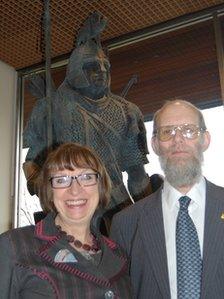Staffordshire Hoard: Mercian trail to 'follow in Saxon footsteps'
- Published

Members of the Mercian Trail Trust hope it will boost tourism
When the Staffordshire Hoard went on display in 2009, more than 110,000 people visited museums in Birmingham and Stoke-on-Trent to see the 3,500 piece collection of Anglo-Saxon gold.
With a recent announcement of 90 more artefacts being found in the same field re-igniting interest, a trust made up of local councils and museums is hoping to cash in on the hoard's popularity.
It is planning a tourist trail, based on the county's Anglo-Saxon past, called the Mercian Trail.
Plans include building a new £750,000 gallery at Birmingham Museum and Art Gallery and new exhibitions at the Potteries Museum in Stoke-on-Trent, Lichfield Cathedral and Tamworth Castle.
Dr David Symons, who is a curator at Birmingham museum, said it had submitted a bid to the heritage lottery fund for the gallery.
He said: "If you mention Vikings, people think York, if you say Roman they'll probably think Bath and we want to turn this region - the western part of Mercia - into the area that people automatically think of when they think of Saxons.
"We're hoping in a few years for people to be able to come to the area, pick up a Mercian trail map and spend a weekend in the region spending tourist money and following in the footsteps of the Saxons."
'Mercia vanished'
There will be two major hoard exhibitions at either end of the trail.
The Potteries museum will focus on the importance of the kingdom of Mercia, while in Birmingham the display will look at how the hoard pieces were made.
Lichfield Cathedral's exhibition will centre on three of its contents: the Anglo-Saxon treasures, the St Chad Gospels and the Lichfield Angel.
Mr Symons said: "If you look at the concept of the seven Anglo-Saxon kingdoms - you've got Essex, Sussex, Kent, East Anglia, Northumbria and Wessex, all of which we still use on maps today.
"Mercia was the one that vanished, and now it only really relates to West Mercia police and the Army regiment.
"We want to make people realise that it was one of the great Anglo-Saxon kingdoms, which in its heyday stretched from the Humber to the Thames."
The Mercian Trail Partnership includes Birmingham Museum & Art Gallery, The Potteries Museum & Art Gallery, Lichfield Cathedral, Lichfield District Council, Tamworth Borough Council and Staffordshire County Council.
The partnership is also being asked to back plans to install a viewing platform overlooking the field in Hammerwich where the hoard was discovered.
'Tourism boost'
It is the idea of Brian Stringer, 73, from Brownhills who said he thought it was "important to have the field commemorated in some way".
He said: "There are signs on the A5 near Hammerwich which tell people that the hoard was found there, but there's nothing to tell casual visitors exactly where it was."
"The farmer didn't want anything in the field itself, so this platform would be just outside with information plaques and maybe a car park."
Mr Stringer has the support of Hammerwich Parish Council, which said it would approach Staffordshire County Council to look at possible funding.

Some people queued for four hours to see the hoard when it first went on display in 2009
Council leader Philip Atkins said he believed the Mercian Trail would be a "major boost for tourism".
"The hoard attracted thousands of people here and put us on the map because every time the hoard is mentioned Staffordshire is in the title," he said.
"The National Memorial Arboretum gets 400,000 visitors each year, which is worth about £25m to the local economy, because visitors stay in local hotels, eat in local restaurants, they go and visit other places.
"The value of the Mercian trail to the local economy could be immense and hopefully it will also encourage business investment in the county."
- Published18 December 2012
- Published18 December 2012
- Published29 October 2011
- Published3 July 2011
- Published16 April 2011